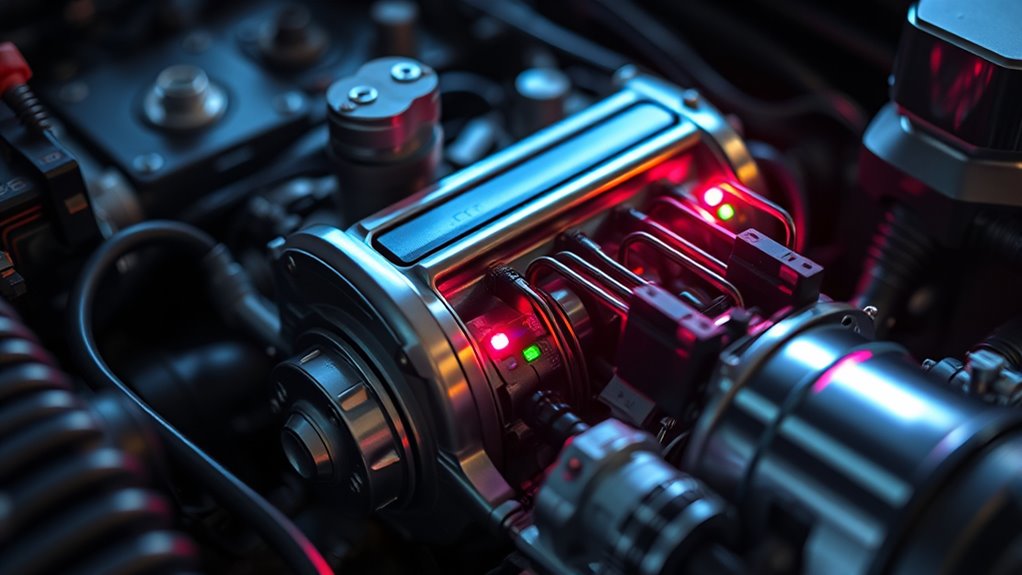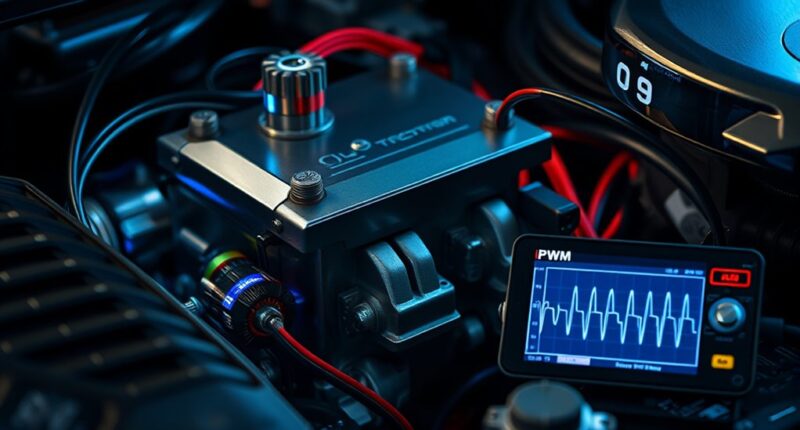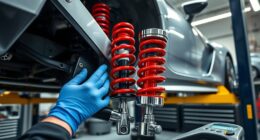Pulse-width modulation (PWM) enhances electric fuel pump performance by precisely controlling power flow, which boosts efficiency and reduces energy waste. It lowers noise levels, extends pump lifespan, and guarantees smoother fuel delivery for better engine response. By adjusting the pump’s duty cycle according to demand, PWM optimizes operation under various conditions. Interested in how this smart control technique can improve your vehicle’s fuel system? Keep exploring to uncover the full secrets behind PWM technology.
Key Takeaways
- PWM optimizes fuel pump operation by adjusting the on/off cycle, enhancing efficiency and reducing energy consumption.
- Proper PWM calibration ensures precise fuel delivery, improving engine responsiveness and overall performance.
- PWM reduces mechanical wear on fuel pumps, extending their lifespan and lowering maintenance costs.
- Adjusting PWM frequency and duty cycle minimizes noise and vibration for a quieter driving experience.
- Fine-tuned PWM controls balance fuel pressure, ensuring smooth operation across various engine loads and conditions.

Pulse-width modulation (PWM) is a technique that efficiently controls the electric fuel pump’s power supply, guaranteeing ideal fuel delivery. By adjusting the amount of time the pump receives power during each cycle, PWM allows you to fine-tune the fuel flow according to your vehicle’s needs. This precise control not only improves fuel efficiency but also minimizes unnecessary energy consumption, helping you get the most out of every drop of fuel. When you implement PWM in your electric fuel pump system, you’re maximizing its operation, which translates directly into better mileage and reduced operating costs over time.
Beyond enhancing fuel efficiency, PWM plays a vital role in noise reduction. Traditional fuel pumps run at a constant high speed, often producing noticeable whines or humming sounds that can be distracting or annoying. With PWM, you can lower the pump’s operational speed during less demanding conditions, greatly reducing noise levels. This makes for a more comfortable driving experience, especially during city commutes or when cruising at steady speeds. The ability to modulate the pump’s activity means your vehicle can operate more quietly without sacrificing performance or reliability.
You’ll find that PWM also extends the lifespan of your fuel pump. When the pump operates at full speed constantly, it faces increased wear and tear. By reducing its duty cycle during lighter fuel demands, PWM lessens mechanical stress, helping your pump last longer and reducing maintenance costs. This smarter operation not only benefits your wallet but also promotes a more sustainable vehicle system by conserving energy and minimizing wear.
Another advantage you gain with PWM is smoother fuel delivery. Instead of abrupt changes in fuel pressure, PWM allows for gradual adjustments, leading to more consistent engine performance. This smoothness can improve acceleration, reduce engine hesitation, and make your driving more responsive. It’s especially useful when the engine’s load varies, such as climbing hills or carrying a heavy load, where you need precise fuel regulation.
In essence, understanding and utilizing PWM for your electric fuel pump unlocks a host of benefits—better fuel efficiency, quieter operation, extended pump life, and more stable engine performance. Properly calibrated PWM can also help maintain optimal color accuracy and ensure your vehicle’s systems operate smoothly under different conditions. By controlling the pump’s power with precision, you guarantee your vehicle runs at its best, saving you money and enhancing your driving experience. It’s a smart, efficient approach that aligns with modern demands for cleaner, quieter, and more economical vehicle operation.
Frequently Asked Questions
How Does PWM Affect Fuel Pump Lifespan?
You might wonder how PWM impacts your fuel pump’s lifespan. By controlling voltage regulation, PWM reduces constant power draw, preventing overheating and excessive wear. This guarantees better fuel pump durability over time. When you use PWM properly, it prevents stress on the motor, extending its life. So, fundamentally, PWM helps maintain your fuel pump’s health, making it more reliable and efficient in the long run.
Can PWM Improve Fuel Efficiency in All Vehicle Types?
Ever wondered if all vehicles can benefit from PWM for fuel efficiency? You might find that PWM helps optimize fuel consumption and boost energy savings in many vehicle types, but not universally. It’s most effective in modern engines with electronic controls. While it can improve efficiency in various vehicles, factors like engine design and driving habits influence results. So, is your vehicle set up to leverage these benefits for better fuel economy?
What Are the Signs of Pwm-Related Fuel Pump Issues?
You might notice fuel pump noise or irregular engine performance if there’s a PWM-related fuel pump issue. Electrical faults can cause the pump to run inconsistently, leading to hesitation or stalling. Unusual whining sounds or difficulty starting your vehicle are common signs. If you experience these symptoms, it is crucial to get your fuel pump checked, as PWM controls can sometimes cause these problems when malfunctioning or faulty.
How Does PWM Compare to Traditional Fuel Pump Control Methods?
Imagine controlling fuel pressure regulation with ancient tech—clunky, inefficient, and prone to hiccups. That’s traditional fuel pump control, where you rely on mechanical or simple electronic methods. Now, enter pulse-width modulation (PWM), the slick, modern wizard that uses electronic control to precisely manage fuel flow. PWM adjusts the pump’s power in tiny pulses, offering smoother operation, better efficiency, and consistent fuel delivery—making old-school methods look like stone tablets.
Are There Safety Concerns With Pwm-Controlled Fuel Pumps?
You should know that PWM-controlled fuel pumps generally pose minimal safety concerns if properly designed. However, you need to contemplate electronic interference, which might disrupt other vehicle systems, and thermal management, since rapid switching can generate heat. Ensuring proper shielding and cooling helps prevent issues. When these factors are managed well, PWM offers a safe, efficient way to control fuel delivery without compromising vehicle safety.
Conclusion
So, after all this, it’s funny how something as simple as adjusting pulse width can make or break your fuel pump’s performance. You’d think the complex world of engines would demand fancy gadgets, but sometimes, a tiny switch is all it takes. Ironically, mastering PWM might just be the secret to reliable fuel delivery—proving that in automotive tech, the simplest solution often hides behind the most sophisticated facade. Who knew?










